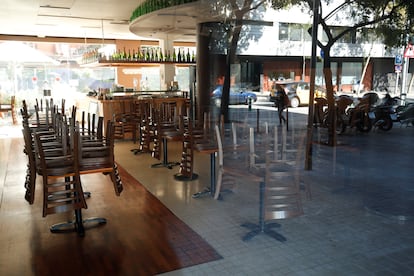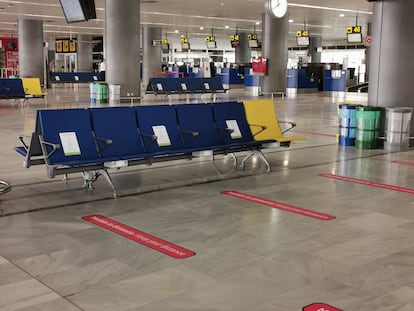Faced with rising coronavirus cases, Catalonia closes restaurants and bars for two weeks
The regional government is seeking to reduce mobility and social interaction in the northeastern Spanish region in a bid to flatten the curve

The Catalan government on Wednesday approved the closure of all bars and restaurants in the region in a bid to slow the spread of the coronavirus. According to data from the regional health department released earlier today, the 14-day cumulative number of coronavirus cases in Catalonia has risen to 290 per 100,000 inhabitants – a figure not seen since the beginning of April.
The decision to shut down bars and restaurants is not due to the fact that these establishments have failed to respect coronavirus safety measures, but rather because they represent the main site of social gatherings, which must be reduced, according to sources from the regional government.
This is the first time one of Spain’s 17 regions has ordered such a drastic measure since the central government’s state of alarm came to an end in mid-June, and regional authorities were put in charge of containing the coronavirus crisis. The measures will come into effect on Friday and remain in place for at least 15 days. Under the new rules, restaurants and bars will still be able to provide home delivery and takeaway.
The move comes amid a spike in coronavirus cases in the region, with the number of weekly infections rising from 7,000 to 11,000 in the space of just a few days. Although this is much lower than the figures being reported by the Madrid region – where the 14-day cumulative number of coronavirus cases is 489 – Catalan authorities have warned that the situation is “very worrying.” More than 1,000 coronavirus patients are in hospital in the region, 189 of whom are in intensive care units (ICUs). Hospitals in Catalonia admitted they are “concerned” about the rise in cases, but say they have not yet had to suspend operations in order to treat Covid-19 patients. Another worrying factor is the speed of transmission in the region. The Rt rate, which measures how many people a positive case will infect, is at 1.3 – higher than the figure (below one) recommended by experts.
Under the new rules, restaurants and bars will still be able to provide home delivery and takeaway
A total of 12,211 new coronavirus cases were detected between October 4 and 10 – double the number diagnosed in the first weeks of September – prompting the Catalan government to look for ways to reduce social gatherings, which are the main source of coronavirus outbreaks. For days, health authorities have been considering restrictions on bars and restaurants, where people are most likely to socialize and let their guard down. Face masks are removed to drink or eat, patrons speak louder and this, in turn, increases the risk of transmission. While regional health chief Marc Ramentol admitted that the food and drink sector has respected safety measures, he said bars and restaurants were “the cornerstone of social interaction.”
The decision, however, still came as a shock to the hostelry industry, which was expecting less-severe restrictions. The sector has rejected the move and threatened to disobey the order, even promising to camp in protest outside the Sant Juan square, where the Catalan parliament is located. “'Let the Catalan police come and close us,' is what many members of the sector are saying,” said Roger Pallarols, the head of the Barcelona Restaurant Association, before meeting with the Catalan government on Wednesday.
The measure has also been criticized by the deputy mayor of Barcelona, Jaume Collboni, who called it “disproportionate.” “The sector has made a very significant effort and we have to remember that less than a week ago there were plans to reopen nightclubs,” he said in an interview with the Cadena SER radio network. Nightclubs and nighttime bars across Spain have been closed since mid-August.
In addition to the closure of bars and restaurants, the Catalan Civil Protection Territorial Plan (Procicat), the regional body responsible for managing the response to the coronavirus pandemic, has also approved other restrictions aimed at limiting social contact: it banned non-professional sporting competition, ordered universities to return to online classes from Thursday and recommended remote working to be prioritized wherever possible.
Catalonia versus Madrid
Under the central Health Ministry’s rules, which were agreed to by a majority of Spain’s regions at the end of September, a city of more than 100,000 inhabitants must be confined if it exceeds the following thresholds: a 14-day cumulative number of coronavirus cases above 500; a positivity rate above 10%; and intensive care unit (ICU) occupancy over 35%.
Catalonia does not meet these criteria, but it is not far off. According to data from the Health Ministry, 7% of hospital beds are occupied by coronavirus patients and occupancy in ICUs is at 19.5%. In the Madrid region, these figures are 21% and 38%, respectively. The worsening evolution of the coronavirus pandemic in Madrid and the regional government’s refusal to take action prompted the Spanish government to declare a state of alarm in the region last Friday, with nine cities – including the Spanish capital – placed under perimetral lockdowns.
English version by Melissa Kitson.
Tu suscripción se está usando en otro dispositivo
¿Quieres añadir otro usuario a tu suscripción?
Si continúas leyendo en este dispositivo, no se podrá leer en el otro.
FlechaTu suscripción se está usando en otro dispositivo y solo puedes acceder a EL PAÍS desde un dispositivo a la vez.
Si quieres compartir tu cuenta, cambia tu suscripción a la modalidad Premium, así podrás añadir otro usuario. Cada uno accederá con su propia cuenta de email, lo que os permitirá personalizar vuestra experiencia en EL PAÍS.
¿Tienes una suscripción de empresa? Accede aquí para contratar más cuentas.
En el caso de no saber quién está usando tu cuenta, te recomendamos cambiar tu contraseña aquí.
Si decides continuar compartiendo tu cuenta, este mensaje se mostrará en tu dispositivo y en el de la otra persona que está usando tu cuenta de forma indefinida, afectando a tu experiencia de lectura. Puedes consultar aquí los términos y condiciones de la suscripción digital.
More information
Últimas noticias
Welcome to the post-religion era: The idea of Christianity as the absolute truth has become obsolete
‘I thought you would like it’: The risky sexual practice popularized by TV shows and TikTok
The digitalization of tourism: ‘They promise experiences and gave us the worst possible one’
Mexican peso defies uncertainty with forecasts of a new period of stability in 2026
Most viewed
- Sinaloa Cartel war is taking its toll on Los Chapitos
- Reinhard Genzel, Nobel laureate in physics: ‘One-minute videos will never give you the truth’
- Oona Chaplin: ‘I told James Cameron that I was living in a treehouse and starting a permaculture project with a friend’
- Why the price of coffee has skyrocketed: from Brazilian plantations to specialty coffee houses
- Silver prices are going crazy: This is what’s fueling the rally











































